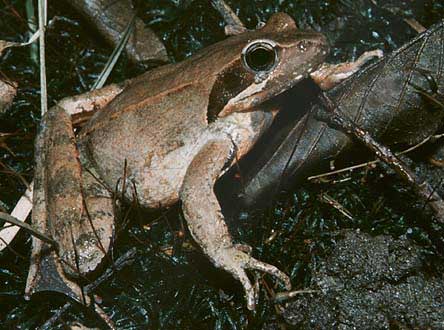
Lithobates latastei (Source)
Superregnum: Eukaryota
Cladus: Unikonta
Cladus: Opisthokonta
Cladus: Holozoa
Regnum: Animalia
Subregnum: Eumetazoa
Cladus: Bilateria
Cladus: Nephrozoa
Superphylum: Deuterostomia
Phylum: Chordata
Subphylum: Vertebrata
Infraphylum: Gnathostomata
Megaclassis: Osteichthyes
Cladus: Sarcopterygii
Cladus: Rhipidistia
Cladus: Tetrapodomorpha
Cladus: Eotetrapodiformes
Cladus: Elpistostegalia
Superclassis: Tetrapoda
Classis: Amphibia
Subclassis: Lissamphibia
Ordo: Anura
Familia: Ranidae
Genus: Lithobates
Species: Lithobates latastei
Name
Rana latastei Boulenger, 1879
Type locality: "adressés de Milan", Italy.
Lectotype: MNHNP 5750.
Synonyms
Rana latastei Boulenger, 1879
Rana (Crotaphitis) latastei — Schultze, 1891
Rana (Rana) latastei — Guibé, 1950
Rana (Laurasiarana) latastei — Hillis & Wilcox, 2005
References
Boulenger, 1879, Bull. Soc. Zool. France, 4: 180.
Hillis and Wilcox, 2005, Mol. Phylogenet. Evol., 34: 311.
Frost, D.R. 2021. Amphibian Species of the World: an Online Reference. Version 6.1. Electronic Database accessible at https://amphibiansoftheworld.amnh.org/index.php. American Museum of Natural History, New York, USA. DOI: 10.5531/db.vz.0001 Lithobates latastei . Accessed on 05 July 2008.
2007 IUCN Red List of Threatened Species IUCN: Lithobates latastei (Vulnerable) Downloaded on 5 July 2008.
Vernacular names
Deutsch: Italienischer Springfrosch
English: Italian Agile Frog
The Italian agile frog (Lithobates latastei or Rana latastei), also known as Lataste's frog, is a species of frog in the family Ranidae (true frogs). The species is native to southern Europe.
Etymology
The specific name, latastei, is in honor of French herpetologist Fernand Lataste.[2]
Description
Rana latastei may attain a head-body length of 7.5 cm (3.0 in). The throat is dark, with a light narrow central stripe.[3]
Geographic range
Rana latastei is endemic to the plains of northern Italy, the extreme southern tip of Switzerland, the Istrian region of Slovenia, and adjacent Croatia.[4] In Italy, populations are reported from four regions: Lombardy, Venetia, Piedmont and Friuli-Venezia Giulia, but the species is most abundant in the former two. Its distribution mainly follows the Po River plains and tributaries.[5]
Habitat
R. latastei is a decidedly lowland species and rarely occurs above 400 m a. s. l., only going up to the lower foothills of mountains, where the colder climate affects larval development.[6] The Italian agile frog inhabits oak and hornbeam-dominated plain woods, hygrophilous woods and riparian woods characterized by white poplar and white willow trees. This types of woods may regularly inundate. It has also been reported from open habitats like wet meadows or peat bogs.[5]
Reproduction
Between late February and mid-April, males and females gather at breeding sites. Reproduction activities occurs in small permanent or temporal water bodies with extensive aquatic vegetation or submerged plant material, such as ponds, ditches or floodplain puddles. The minimum water temperature for egg deposition is reported as 2°C, and eggs hatch after 10 to 15 days. As with other European frogs of the genus, metamorphosis is completed after circa 3 months. Females leave the breeding site immediately after spawning, whereas males and juveniles remain there for up to 5 weeks.[5]
Conservation Status
The IUCN lists this species as Vulnerable (VU).[4] Major threats include habitat destruction and fragmentation, as it is highly adapted to the floodplain woods of the Po River basin. To enhance the protection of this species, several conservation areas were proposed in Italy, and frog tadpoles bred and translocated to suitable sites.[7]
References
IUCN SSC Amphibian Specialist Group (2020). "Rana latastei". IUCN Red List of Threatened Species. 2020: e.T19156A89698776. doi:10.2305/IUCN.UK.2020-3.RLTS.T19156A89698776.en. Retrieved 18 November 2021.
Beolens, Bo; Watkins, Michael; Grayson, Michael (2013). The Eponym Dictionary of Reptiles. Exeter, England: Pelagic Publishing Ltd. xiii + 262 pp.
ISBN 978-1-907807-41-1.
Arnold EN, Burton JA (1978). A Field Guide to the Reptiles and Amphibians of Britain and Europe. London: Collins. 272 pp. (Rana latastei, pp. 81-82 + Plate 11 + Map 39).
"IUCN Red List of Threatened Species: Rana latastei". IUCN Red List of Threatened Species. 14 December 2008. doi:10.2305/iucn.uk.2009.rlts.t19156a8845034.en. Retrieved 17 April 2020.
Barbieri, Francesco; Bernini, Franco (1 January 2004). "Distribution and status of Rana latastei in Italy (Amphibia, Ranidae)". Italian Journal of Zoology. 71 (sup1): 91–94. doi:10.1080/11250003.2004.9525542. ISSN 1125-0003.
Ficetola, Gentile Francesco; Bernardi, Fiorenza De (2005). "Supplementation or in situ conservation? Evidence of local adaptation in the Italian agile frog Rana latastei and consequences for the management of populations". Animal Conservation. 8 (1): 33–40. doi:10.1017/S1367943004001805. ISSN 1469-1795.
Scali, Stefano; Gentili, Augusto; Barbieri, Francesco; Bernini, Franco; Vercesi, Alberto (15 November 2001). "Un progetto integrato per la conservazione degli anfibi in Lombardia" (PDF). Pianura. 13: 21–123.
Further reading
Boulenger GA (1879). "Étude sur les grenouilles rousses, Ranæ temporariæ et description d'espèces nouvelles ou méconnues ". Bull. Soc. Zool. France 4: 158–193. (Rana latastei, new species, pp. 180–183). (in French).
Retrieved from "http://en.wikipedia.org/"
All text is available under the terms of the GNU Free Documentation License

